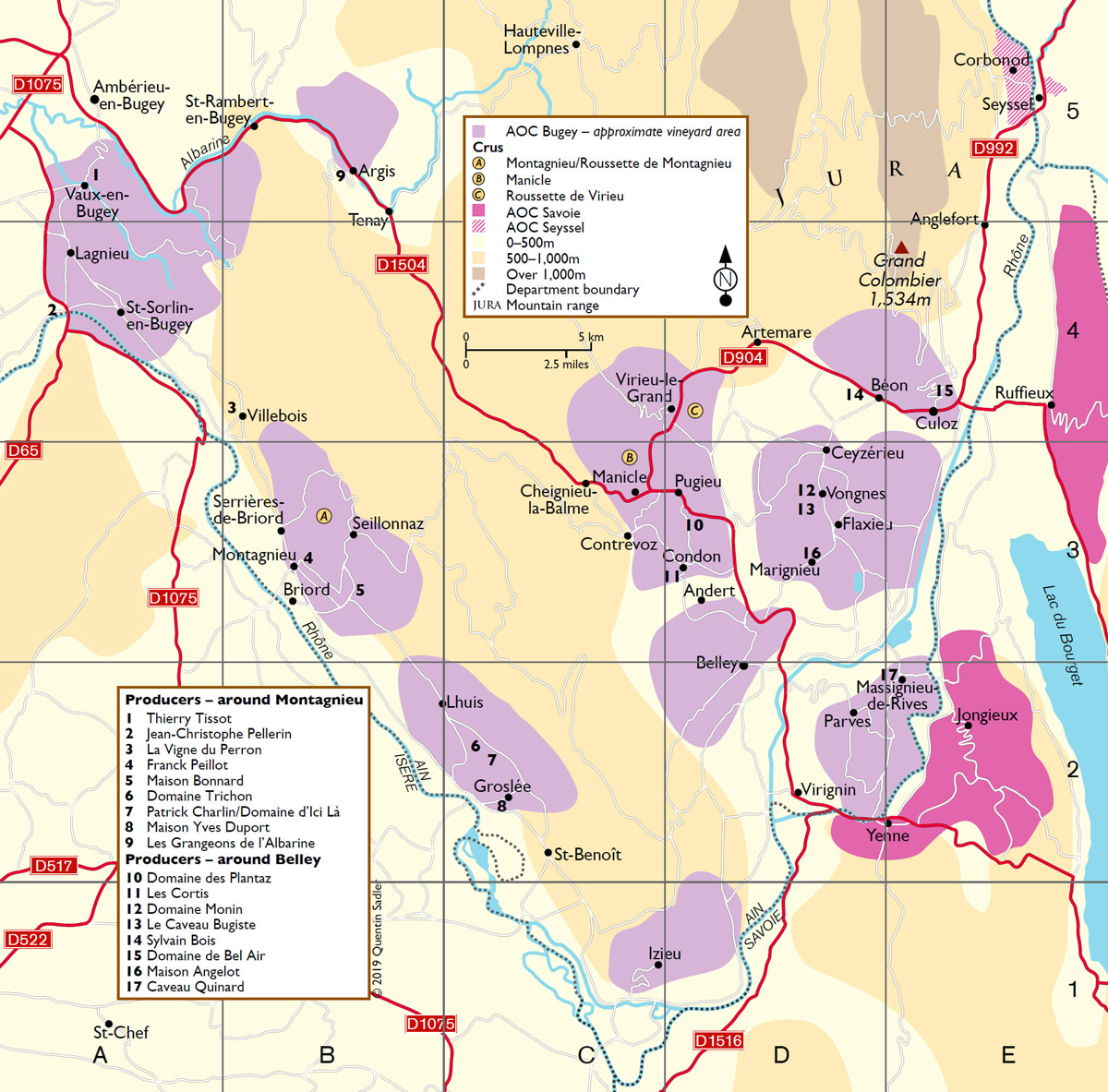
SOUTHERN BUGEY
South of the town of Ambérieu-en-Bugey, the scattered vineyards of southern Bugey lie within a huge loop made by the Rhône river. Here there are ever-present low mountains, often in the form of long ridges (those Jura fingers, mentioned in the Bugey introduction), and it is one of these that divides the vineyards into two further parts. The quieter western part includes the spectacular vineyard slope of Montagnieu. Fitting in neither part, a tributary of the Ain, the pretty Albarine river, winds from east to west through some dramatic gorges. Between St-Rambert-en-Bugey and Tenay there were once many vineyards, but today almost all that remain are those farmed by Les Grangeons de l’Albarine at Argis.
The eastern part is dominated by the Grand Colombier mountain in the north, which has views across Savoie to Mont Blanc and the Alps. Belley, located here, is the unofficial capital of the wine area and a modest town with a population of less than 9,000. It was the birthplace of the lawyer, politician and gastronome Jean-Anthelme Brillat-Savarin, whose most famous work, The Physiology of Taste, was published in 1825. He is known to have taken a great interest in the wines of Bugey and even owned vineyards. The Rhône separates this southeastern part of Bugey’s vineyards from the Chautagne and Jongieux vineyards of Savoie; just to the north is the town of Seyssel, which straddles the Rhône river, with one part in Ain and the other in Haute-Savoie. Seyssel’s vineyards are treated as part of Savoie.
The main wines to expect
Most producers in southern Bugey make a significant amount of sparkling wine, often 50% or more of their output. The main sparkling wine is Bugey Brut, usually Chardonnay-based; those with vineyards in Montagnieu also make Bugey Montagnieu Brut. Many also make a white and/or rosé Vin de France sparkling wine in the style of a Méthode Ancestrale: medium sweet and low alcohol. In still whites, everyone makes at least one Chardonnay; from Altesse some produce Roussette du Bugey (including Roussette du Bugey Montagnieu) and there are a few other varietal whites. Rosé and reds are mainly varietal wines from Pinot Noir, Gamay and sometimes Mondeuse.
Around Montagnieu
In the southwestern part of Bugey, the vineyards stop and start in a line southeast from Vaux-en-Bugey to beyond Groslée-St-Benoît (two villages linked together administratively), above the Rhône river. The most spectacular and contiguous vineyard area is that of Montagnieu, the only cru in this area, which is restricted to the villages of Montagnieu, Briord and Seillonnaz. Unfortunately, from many vantage points the view across to the Rhône river and the department of Isère on the other side is spoilt by the all-dominating Bugey nuclear power plant. But take time to explore the villages here and you will find charming stone churches, communal wash houses (lavoirs) and old vigneron houses, where they made their wines too. In the vineyards are many distinctive grangeons.
Starting in the north, Vaux-en-Bugey, Lagnieu and St-Sorlin-en-Bugey were all once widely planted with vines and have some fine historical vineyard sites, with several being rehabilitated, such as Mataret above Vaux, which has been replanted by Thierry Tissot, and others by Jean-Christophe Pellerin. If you visit in summer, pause for a walk around St-Sorlin, which is known in Bugey as the village of the roses, with climbing roses clinging to most of the buildings along its steep little streets.
The largest cru in southern Bugey, Montagnieu has around 32ha of vineyards of which about 24ha are designated for sparkling wine, predominantly from Chardonnay. It can be very good indeed and I believe it is the finest traditional method wine area in the Alps. Montagnieu’s vineyards were effectively rescued from extinction after the Second World War, and it was sparkling wine that saved them. Maison Guigard, of Groslée, was known for traditional method sparkling wines made from bought-in base wines, but from the 1950s Pierre Guigard encouraged local growers to plant more Chardonnay and purchased much of their harvest. Today, Guigard’s production has declined greatly and is sold locally. Guigard shares a CUMA with Yves Duport, Maison Bonnard and Franck Peillot, for disgorging sparkling wines.
Montagnieu’s steep south/southeast-facing slope extends up to above 400m. While predominantly on clay-limestone scree, it has parts that are of very heavy clay; some more friable gravelly clay or marl; other parts rich in fossils; and sections of glacial till – in all a classic combination of Jurassic and Prealpine soils. Mondeuse and most particularly Altesse have been grown on this slope since at least the 19th century and although areas planted today are small, these grapes can produce excellent results. Franck Peillot claims that the celebrated Beaujolais négociant and taster Jules Chauvet rated the potential of Altesse from Montagnieu on a par with Château-Chalon or Château Grillet. This area is not without its viticultural problems, though – apart from being fiendish to work, it seems unfairly prone to both severe spring frost (especially on the lower slopes) and hailstorms. The vineyards of Bénonces and Villebois are effectively an extension to the north, but are not in the designated cru area.
South of Montagnieu, with mixed limestone soils with some sand and silty clay, Lhuis’s vineyards vary from steep slopes to flatter frost-prone land, closer to the river. Groslée-St-Benoît has several impressive steep vineyard sites.
Maison Bonnard
There is much respect for the Bonnard family in Bugey, and rightly so, even though they are hardly known outside. Their very drinkable Mondeuse was offered to us over lunch with Raphaël Bartucci in Cerdon; Jean-Christophe Pellerin, who works in biodynamics, told me he was giving the Bonnards a hand; and Roland Bonnard is active in the Bugey syndicate – the whole family is friendly and open, what’s not to like?
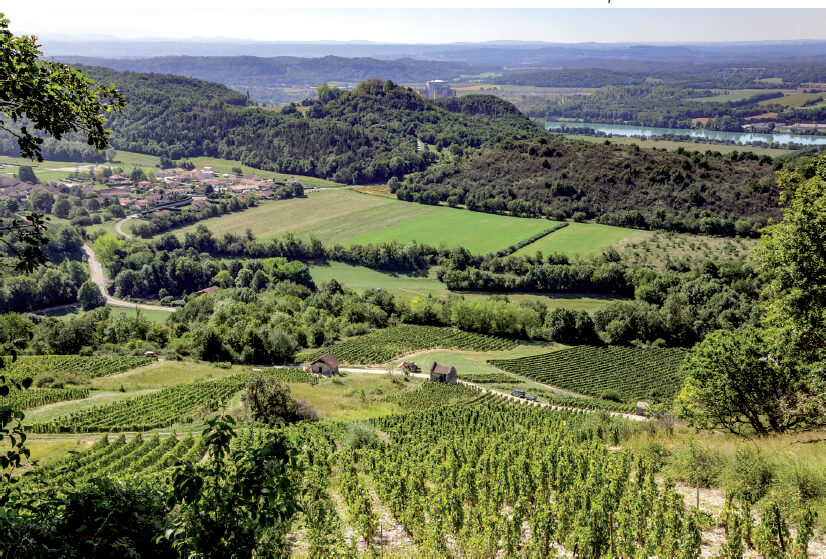
South of Montagnieu, these vineyards in Lhuis overlook the canalized part of the Rhône.
Based in Crept, at the foot of the Montagnieu vineyard slope, when brothers Roland and Frédéric established the estate in 1988 they just had a tractor and 1.5ha of vines on the plain. Gaby Bonnard, their late father, was a mixed farmer, who loved to party, according to grandson Romain, who is bringing youthful life to this estate. Whenever Gaby had any money to spare, he bought land, mostly close to the winery in Crept.
They started moving towards organic farming in their vineyards from 1998 – the previous year Frédéric had been plagued with headaches. Now the whole estate is weeded with a hoe or an intercep, depending on the slope, and organic certification is on the way. They are also adopting biodynamic practices, from using the plant preparations to making their own concoctions from plants picked in the local hillsides and to working with the lunar cycles. Everything is hand harvested. Above Briord, the Montagnieu slope is steep, limestone scree, well drained and retains the heat, so it’s ideal for both Mondeuse and Pinot Noir. They grow Altesse towards the village of Montagnieu, where there is more marl. Chardonnay can lose acidity too quickly on the well-exposed Montagnieu, with ever-increasing warmth and frequent drought, so in future years they plan to plant more traditional varieties such as Jacquère, Verdesse or Persan. Their 4.5ha of Chardonnay in Lhuis will be gradually reduced, as it is a frost-prone site.
Sparkling wines account for around 40% of production, with a Vin de France ancestral method rosé but the majority being the Montagnieu Brut. Made from Chardonnay, usually with a touch of Altesse and sometimes Pinot Noir or Mondeuse, the Montagnieu is hand riddled and remains about three years sur lattes. It’s very good, as is the range of still red and white wines, fermented with indigenous yeast and vinified simply, with some old oak use. There are two Chardonnays, notably the oak-fermented Les Bonnes, and a Roussette de Montagnieu, but it is their reds that impress particularly. These include a juicy, whole bunch carbonic Gamay (the CO2 is recycled), a satisfying Pinot Noir (usually half destemmed) and an excellent classic sour-cherry, structured Mondeuse, made from low yields, mainly destemmed and spending some months in old oak. Another plan is to hold back some Mondeuse and Altesse bottles for later release.
Jean-Christophe Bonnard, a son of André, brother to Roland and Frédéric, has joined the team after his wine studies and works with Roland on soil and canopy management in the vineyards. Frédéric handles the vine treatments, as well as the sales and admin work. His son Romain studied wine at Belleville, then wine business at Dijon, and he works on all sides. Before settling back in Bugey, Romain worked at Domaine Barraud in Pouilly Fuissé and at the biodynamic Domaine d’Aupilhac in the Languedoc, owned by his godfather.
This is a close-knit family, with big projects for the future. Romain’s sister Anne-Sophie joined them in 2018, back from travelling the world on a quest to discover the key to wine tourism (she is La Wine Trotteuse on social media). She is masterminding the development for 2020 of lodgings and meals in old vineyard grangeons, plus a wine bar to increase sales at the domaine. Currently they sell much in Lyon and Paris, and exports are minuscule. The future for Maison Bonnard is a fine one, I predict.
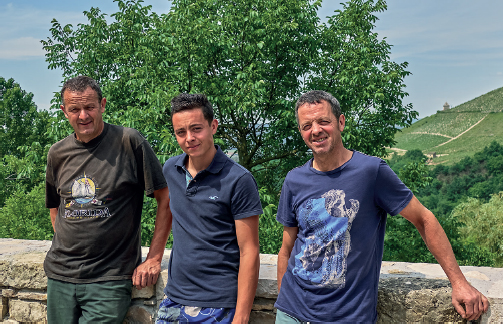
Roland, Romain and Frédéric Bonnard, with some of their steep Montagnieu vineyards behind.
Maison Bonnard
Hameau de Crept, 01470 Seillonnaz
Tel: 04 74 36 14 50
Email: bonnardfils@orange.fr
Web: maisonbonnard.fr
Contact: Romain Bonnard
Map ref: B3
Vineyards: 16ha
Certification: Alpes Contrôles
Visits: Tasting room
Patrick Charlin
The most thoughtful Bugey vigneron, Patrick Charlin retired after the 2017 vintage having made wine for four decades; rather sadly, his children had no interest in taking over the estate. Having already reduced his holdings to 4.5ha, mostly in Montagnieu, the remaining vineyards have been taken on partly by the new estate Domaine d’Ici Là, which is also renting his cellars, and partly by Yves Duport.
Patrick’s father Pierre was a mixed farmer, and, after studying at Beaune, from 1977 Patrick started to acquire land and vines. He has been a rare champion of Altesse – specifically, Montagnieu Altesse – and from the 1990s he started focusing on the grape’s quality potential. His vineyards were grassed down for many years and more than a decade ago he began gradually converting to organic farming, although he never sought certification. He always preferred hand harvesting.
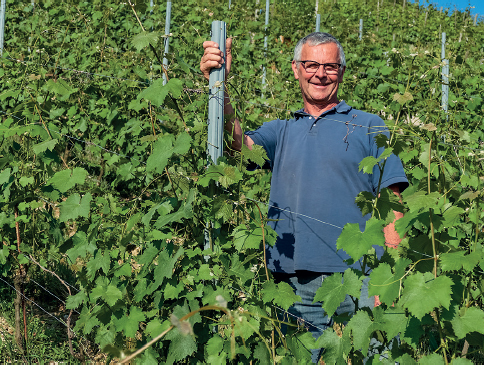
Patrick Charlin farmed his Montagnieu vineyards for 40 years.
Patrick worked for a while in Champagne and has made fine sparkling wines. Although he grew Chardonnay and Pinot for Bugey Brut, he found Montagnieu Brut easier to sell and for many years concentrated on this, making a fine one, usually from one-third each of Chardonnay, Altesse and Mondeuse, sometimes blending vintages, and with a low 4g/l dosage. Like his Chardonnay-dominated Bugey Brut it could age well, and this is the essence of Patrick’s wines – he made them to age, releasing them later than most producers.
Overall his winemaking was always considered – whole bunch white grapes and, as in Champagne, he discarded the first and last juice from the press. He used the same yeast for whites as for his sparkling base wine, started fermentation at a low 12°C and avoided malolactic or racking. For his Mondeuse he picked very late and in more recent vintages used 30% whole bunches, for a little semi-carbonic maceration, to help liberate the spicy, peppery flavours.
Patrick’s Altesse needs some ageing to show its best and he releases it at nearly three years old; waiting allows truffle flavours to evolve, as well as weight on the palate. Ten years old is nothing for this wine from a good vintage – acidity is normally a given, although Patrick is worried for the future with a warming climate, noticing he had too much alcohol in his Altesse in later years. His rustic and intense Mondeuse benefits from time too, but he releases it a little earlier. Patrick carefully ekes out his stocks and has even sold some to Becky Wasserman in the US. I urge you to snap up what you can. For now, they are great value.
Patrick Charlin (retired)
Le Richenard, 01680 Groslée
Tel: 04 74 39 73 54/06 25 90 50 67
Email: charlin.patrick@gmail.com
Map ref: C2
Visits: Tasting room, preferably by appointment, while stocks last
Maison Yves Duport
Yves Duport is a good talker, and as a child he was a voracious reader – a fan of Jacques Cousteau and Paul-Emile Victor, explorers and scientists. He had originally put his faith in both history and science. As an adult, while remaining a history fan, Yves finds the more he learns, the more he distrusts science. He’s read Rudolf Steiner but bemoans the fact that he never explained the ‘why’ of anything. Nevertheless, Yves increasingly practises biodynamics in his vineyards, which have been organic since 2009.
The Duport family was originally from Vaux-en-Bugey, then, having married a local girl, Yves’ grandfather settled in Groslée to farm (including vines) in the 1930s. Yves’ father Jean and his uncle Jacques worked together from 1970 and Yves joined them in 1992. He had studied commerce in Paris and wine in Mâcon and worked in sales both for a Mâconnais wine co-operative and for Savoie négociant, Jean Cavaillé. After a family split, from 1996, Yves worked with his brother and father to create a négociant business, buying grapes mainly from Montagnieu for sparkling wine and fully equipping a modern cellar to make it. His brother moved on, a partner came and went, and finally, in 2007, Yves started again on his own with his wife Céline. Daughter Lucie, originally in banking, is retraining in wine to join them.

Yves Duport’s wide range of wines pleases many markets.
Yves has built up his domaine to 15ha, including 2.7ha of Patrick Charlin’s Montagnieu Chardonnay and Altesse taken over in 2018, but he has to obtain organic certification for this. He also has vineyards in Groslée, notably on the hillside below the Château du Groslée, which had not been replanted since phylloxera. Yves has planted Pinot Noir on the rockier, iron-rich, red soil (naming the wine Terre Rouge) and Mondeuse on the deep, brown soil higher up (Terre Brune). He plants mass selections when possible, ploughs the soils, uses the two main biodynamic preparations ‘when he can’ and works with various plant infusions. He uses machine harvesting for some of his Chardonnay Les Côtes, whereas reds are always hand harvested.
For whites, Yves ages in tank, encourages malolactic fermentation and uses extended lees contact; he ages the reds in second-hand barrels, purchased from Domaine Tollot-Beaut in Burgundy. Yves makes a yeast starter culture from his natural yeasts early on and uses this throughout – for his top sparkling wine he makes his own liqueur de tirage (the yeast and sugar mixture) for the second fermentation. His sulphur levels are kept extremely low.
The Montagnieu Brut – a blend of Chardonnay (part purchased) with Altesse, Mondeuse and Jacquère shows off the cru well with elegance, clean lines and length. The Bugey Brut Origine’L Reserve, from his own Chardonnay, Pinot and Aligoté, is a softer, rounder sparkling wine – much more in line with all the rest of Yves’ organic wines. These wines taste like no others from this part of Bugey – they are riper, rounder and more forward, yes, more natural too. I get the sense that Yves takes risks, but he has found a customer base in Paris and on export markets (about 15% including to Japan and the UK) who understand his wines. Yves does Altesse and Mondeuse well and they have a well-deserved following: the Altesse de Montagnieu En Chinvre from a very steep part of Montagnieu on white marl, with plenty of ammonite fossils, has focus and class; the Mondeuse Terre Brune has weight to cope with the oak maturation. Expect the unexpected with Yves in his wines or when meeting him. Every region needs an Yves.
Maison Yves Duport
821 Route du Village, Le Lavoir, 01680 Groslée-St-Benoît
Tel: 04 74 39 74 33
Email: contact@yvesduport.fr
Web: yvesduport.fr
Map ref: C2
Vineyards: 15ha + some Chardonnay purchases
Certification: Ecocert (for part)
Visits: Tasting room, preferably by appointment
Les Grangeons de l’Albarine
His wines are listed by Noma restaurant in Copenhagen, but in his short time as a vigneron, life has delivered joy and pain in equal measures to Luc Bauer. Having worked as a full-time vigneron for just over a year, in May 2016, along with problems with his vineyard equipment Luc was fighting rampant mildew in his biodynamically run vineyards due to the rainy spring. In July the sun returned, he and his partner Clémence moved into their newly restored house above the winery… and two days later he was rushed to hospital having suffered a serious stroke. He battled through, getting close to the void before he got better. He was just 34 years old. The local organic vignerons rallied round to look after his vineyards and Luc sold them his 2016 crop. He wasn’t officially allowed back to work until March 2017, but meantime in January there was joy, with a baby daughter, Mélina. He was just celebrating being able to bottle his wonderful 2015s and return to the vineyards when, like many other growers, he was hit by the debilitating frosts of April 2017. He did have some crop in 2017, and fortunately vintage 2018 is what he describes as his real renaissance, with a potential volume of more than 12,000 bottles.

In his isolated Argis vineyards, Luc Bauer uses this kite as a bird-scarer.
Luc studied agronomy and initially worked in the intensive grain industry – he quickly became disenchanted and developed an interest in agrobiology. Clémence is from Alsace and through her family Luc discovered a love for wine. He took a wine course at Mâcon Davayé in 2008 and worked for various domaines in France and Canada, most notably discovering biodynamics while working with Bret Brothers in the Mâconnais. In 2010 he started work in Beaujolais as an organic vineyard consultant while also looking to establish his own vineyards. Instead of Beaujolais, in 2011 it was in Bugey that he found what he was looking for. On the almost abandoned southwest-facing steep vineyard slope above the village of Argis and the Albarine Valley below the Roche de Narse, he took on two young vineyard parcels, Le Paradis and Le Château, totalling 0.8ha. They had been planted by a wealthy but rather clueless Parisian wine lover, who had effectively given up, so Luc had to bring the vineyards back to life, converting immediately to organics, while keeping on his day job. The name he gave to his winery is a tribute to the grangeons (vigneron huts) that once covered this slope of the Albarine Valley – Luc’s informative website/blog shows a detailed interest in his adopted home and environment. His winery is in a hamlet on the slope opposite the vineyard.
With new plantings in 2015 and 2016, today Luc has 1.4ha above Argis with Altesse, Mondeuse and Chardonnay. Benefiting from sun all day, the vineyards are on a classic limestone scree soil, with some parts of white marl, ideal for Altesse. They are steep and he works with a chenillette, ploughing the soil and using biodynamic preparations. Near Manicle in Rossillon, Luc rents another plot with old Gamay, Chardonnay and Aligoté and in Ceyzérieu he has a plot of Mondeuse (for his wine Miss Monde) and Chasselas, from which he now makes grape juice but in 2016, after his stroke, he was able to pick it himself and made a vin de paille. He also farms a plot in St-Sorlin with Altesse, Gamay and Aligoté and today has a full-time employee who manages this.
From Luc’s first vintage in 2011 he quickly developed a customer following for his natural way of making the wines – all whole bunch, no chaptalization, natural yeasts, long ageing on lees in used oak barriques and demi-muids plus very low sulphur levels, added only just before bottling. From 2017 he has been working also with stoneware jars and says that in 2018 he can really test whether the oak or jars are best. He has exported to the US, Japan and Scandinavia in addition to naturally-orientated bars and shops across France.
There is wonderful minerality in the whites from Argis and a riper character in those from the Rossillon vineyards, which have alluvial soils with round glacial pebbles. Luc is passionate about Bugey, but after trying to work within the AOC regime, he has given up and his wines are labelled Vin de France. The potential of the Altiesse en Paradis (Altiesse, with an ‘i’) is huge. And Luc’s two Mondeuse wines are entirely different – Le Château from Argis is more structured and Miss Monde from a warmer plot in Ceyzérieu is more joyous; both usually weigh in at 10–11% alcohol. A range of other wines is made, varying from year to year.
Luc suffered a lot of knockbacks in a short time, but he bounced back with determination, enthusiasm and great talent too. Providing the stars align better for him, with the support of his family, his colleagues and customers from around the world, his future could be very bright indeed.
Les Grangeons de l’Albarine
La Pavaz, 01230 Argis
Tel: 06 42 79 43 84
Email: grangeons_albarine@yahoo.fr
Web: lesgrangeonsdelalbarine.blogspot.fr
Contact: Luc Bauer
Map ref: B5
Vineyards: 2.7ha
Certification: Ecocert
Visits: By appointment only
Domaine d’Ici Là
The arrival of this ambitious young couple in 2018 means a few more hectares are added to the growing area of Bugey’s organic vineyards. These include just over a hectare of some of the most meticulously farmed vineyards on the fabulous slope of Montagnieu, belonging to Patrick Charlin. Florie Brunet and her partner Adrien Bariol had been looking for the right vineyard area to set down their own roots for some time and, in their words, when they met Patrick, they just happened to be in the right place at the right time. He was able to lease them 1.3ha and his winery buildings, alongside, importantly, the promise of his sage advice and support.
Although neither Florie (from Alsace) nor Adrien (from Isère) grew up in winegrowing families, independently they both were drawn to wine – Florie’s father was a gastronome and wine lover – and later they were both attracted to an organic approach. They met in the Coteaux Lyonnais at the organic Domaine du Bouc et la Treille, where Florie had worked for three years since leaving wine college and Adrien had come for seasonal work after his studies in the northern Rhône.
Apart from several parcels of Patrick Charlin’s Altesse and Mondeuse vines, and some other small parcels with Gamay and Chardonnay in Montagnieu, they have leased a steep vineyard in Groslée with Altesse and Mondeuse, and some easier, flatter land, planted with Chardonnay, in Lhuis, ideal for sparkling wine. Unfortunately, while working hard to convert all the vineyards to organics, on the night of 29/30 May 2018, their Montagnieu vines were almost completely destroyed by a hailstorm. Thanks to their other vineyards, for their first vintage they were able to harvest some of each of their four varieties. Half the Chardonnay is destined for Bugey Brut (in future years they will also make Montagnieu Brut), the rest for two still whites, one made with long skin contact; a tiny cuvée of carbonic maceration Gamay is being released early with no added sulphur; and later there will be small amounts of Altesse and Mondeuse.
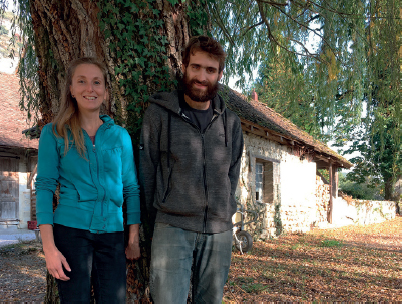
New kids on the block: Florie Brunet and Adrien Bariol.
They have made a sensible start, observing their vineyards, focusing on managing the soil, experimenting with herbal sprays. For year one the wines were made in tank, using cultured yeasts for white, indigenous for reds. They hope never to have to chaptalize and always to use low sulphur levels. For 2019 they plan to buy some second-hand barrels and perhaps some earthenware jars. Ambitious indeed, but with some steadying help from Patrick, I hope they will be rising stars.
Domaine d’Ici Là
190 Impasse du Richenard, 01680 Groslée-St-Benoît
Tel: 06 70 39 32 28/06 95 00 51 31
Email: contact@domainedicila.fr
Web: domainedicila.fr
Contacts: Florie Brunet or Adrien Bariol
Map ref: C2
Vineyards: 5ha
Certification: Qualisud
Visits: Preferably by appointment
Franck Peillot
In 1998 Alain Renardat-Fâche from Cerdon brought the late Joe Dressner, his US importer, to visit Franck Peillot. Joe fell for Franck’s Mondeuse and Altesse and immediately shipped 300 bottles of each – these may well have been the first wines from these grapes available in the US. In a story that Franck enjoys relating, the following year Joe returned, and gently suggested Franck might try working as his father, Jean, once did, using indigenous yeasts. Franck says Joe simply nudged him, didn’t insist. Franck is not an organic vigneron: everything he does, from planting to bottling, is considered carefully, yet he is not a big risk-taker. For whites he now always uses indigenous yeast, for reds he uses a cultured yeast to make a pied de cuve, the fermenting starter juice to get the rest going naturally, allowing him to avoid using SO2 until after malolactic.
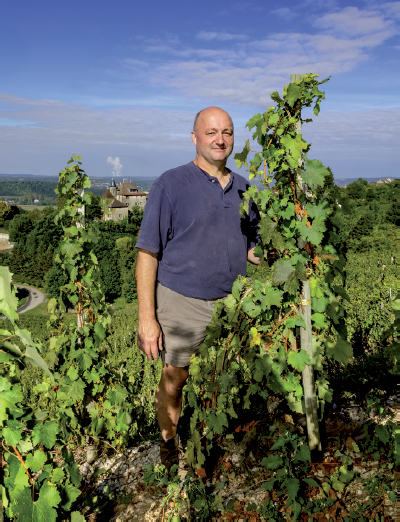
High up in his Montagnieu vineyard, Franck Peillot is a champion for training vines sur échalas.
Franck’s great-great-grandfather, Etienne Babolat, lived in nearby Isère and worked for a vine-grower; his son, Jean-Claude Sambet, bought 0.3ha of vines in Montagnieu. These vines were taken on by Jean-Claude’s son-in-law, Franck’s grandfather, Louis Peillot (1906–1975), who was a mixed farmer. Franck’s father, Jean, continued and in 1968 sold his cows to focus on his 1.5ha of vines, including Altesse and a little Mondeuse. With Altesse he would make a sparkling wine, effectively using the ancestral method but without disgorging the yeast – Franck explained that as the climate isn’t as cold as Cerdon, the fermentation in bottle would go on for longer, giving a drier wine.
Franck studied wine at Mâcon and initially had a difficult time settling between military service, working with his father and for the Duport family. Eventually in 1988 he joined his father full time. Together they planted Chardonnay for sparkling wines. His father insisted they should always make their Roussette du Bugey exclusively with Altesse, even though for the VDQS (pre-AOC), Roussette could also contain Chardonnay. To emphasize their use of Altesse, the Peillots not only wrote it on the label (unheard of, then) but also added their distinctive ‘Royal’ Fleur de Lys (Altesse means ‘Highness’).
Today Franck’s vineyards are in several plots in and around Montagnieu, and in nearby Lhuis, where he took over an uncle’s vines. He still has a proportion of very old vines planted by Louis; other plantings date from the late 1970s, and some clones were planted in the 1990s and 2000s. His steeper Montagnieu vineyards of Altesse and Mondeuse are planted at a density of 9–10,000 vines per hectare with low-trained Gobelet sur échalas – Franck is a big fan of this training. Franck used to hoe and bank up all his steep vineyards to avoid weed-killer, but says the work is just too much and today he uses herbicide reluctantly, which he can avoid by using an intercep on his Guyot-trained, flatter vineyards. For treatments he uses systemic chemicals at the start of the season and then moves onto sulphur and copper. Harvesting is manual.

Franck’s largest production is his delicious Montagnieu Brut, made from a base of about 40% Altesse, 30% Mondeuse and 30% Chardonnay, with a plan to reduce the latter. Each vintage he does a single blend and usually two bottlings, keeping the wine sur lattes for 12–36 months and disgorging regularly. The Mondeuse content is relatively high; he started using it in 2008 when the Mondeuse vines were young, and found it adds a fruity, vinous character. Franck doesn’t want his sparkling wine to taste like Champagne, he wants it to taste like Montagnieu. And it does – just off-dry at 6g/l dosage, with a lovely leesy character on the nose, very delicate mousse and a crispness to offset the sweet fruit. There is also a 100% Chardonnay Bugey Brut named Réserve de Jean – it’s creamy and minerally, but personally I love what Altesse and Mondeuse give to the Montagnieu.
For still wines there’s a simple, eminently drinkable Chardonnay with freshness and creamy lees character, and a deliciously light, juicy Pinot Noir, from vines of the Pinot Droit (Champagne) clone. The stars are two Altesse wines and his Mondeuse. In 2011 at a tasting of old Bugey vintages from 2009 back to 1994, the absolute standouts were three vintages of Franck’s Mondeuse in magnum; his Altesse offerings were also in magnum and very impressive.
Matured only in tank, the main Altesse cuvée is bottled partly in spring and partly in summer and needs a few months to show its potential. Franck usually filters to prevent malolactic though in some tanks it just happens. Residual sugar levels vary – 2016, for example, had as much as 7g/l, but balanced by the fresh acidity and leesy character the sweetness isn’t noticeable. Made only in exceptional years, in limited quantity, Altesse QV à Louis is a blend of the main wine with a late-harvest selection, though rarely with botrytis. When pronounced in French, QV is ‘cuvée’ and this is dedicated to his grandfather Louis, with the same label design he used in 1935. Franck started making it in 1994 when Altesse was believed to be the Furmint grape and he wanted to try making a Tokaj-style wine. With a rich texture, almost a sweet-sour character, QV becomes more honeyed and spicier with time. The last vintage released was 2013.
Franck is the largest producer of Montagnieu Rouge, a mere 6,000 bottles on average. He destems partially and crushes by foot before a maceration of about ten days. He ages the red in tank, bottling within the year, allowing it to mature in bottle for a couple of years before release. This Mondeuse has plenty of tannic grip, giving a rustic edge, and it’s a while before the floral and fruit character emerges.
Franck’s adult children show no interest in working on the estate and he has a very young family with Morgane, his second wife. Théo Bonnard (of the Bonnard family above) and his partner work for him and Franck hopes they may take over one day. Living right in the heart of the village of Montagnieu, Franck is one of the proudest ambassadors for its vineyard and for its emblematic Altesse and Mondeuse grape varieties.
Franck Peillot
Route de Seillonnaz, 01470 Montagnieu
Tel: 04 74 36 71 56/06 81 56 11 94
Email: franckpeillot@aol.com
Map ref: B3
Vineyards: 8ha (3ha each of Altesse and Mondeuse; 1ha each of Chardonnay and Pinot)
Visits: Tasting room, preferably by appointment
Jean-Christophe Pellerin
In the winery, you mustn’t get stressed: this is the maxim of Jean-Christophe Pellerin, Bugey’s only Demeter-certified biodynamic winemaker. Jean-Christophe’s great-great-grandfather had 14ha of vineyards in St-Sorlin, with a large wine cellar of cement tanks and two stills for making spirits. By the time of Jean-Christophe’s grandfather only 5ha remained, all hybrid vines. Jean-Christophe remembers working with him in the vines as a child – sadly his father had died when he was only two. His studies in electrical engineering did not inspire him and after a period teaching kayaking, in 1986 Jean-Christophe started work for Lingot-Martin in Cerdon and later for Domaine Trichon. In 1999 he rented a hectare of vines in St-Sorlin, planted another, and gradually took on more. Like everyone else at the time, he had mainly Gamay and Chardonnay, but more recently he has diversified – and not only with grape varieties.
By the mid-2000s Jean-Christophe was working his vineyards sustainably and in 2007 he booked himself onto a course for vignerons about plant preparations. He was immediately inspired. In late 2008 he studied biodynamics with Pierre Masson and subsequently became Ecocert and later Demeter certified, making his own biodynamic preparations. In the winery he uses natural yeasts, very low sulphur levels and doesn’t chaptalize. He doesn’t even add sugar for the second fermentation of his traditional method sparkling wines. Jean-Christophe thinks that to work in the cellar successfully like this one must be fully committed and to believe it will work.
Since 2011 Jean-Christophe has felt that he has no option other than to work outside the constraints of the Bugey AOC, something that still makes him sad. Some of his vineyard parcels are outside the AOC limits, some of his grape varieties are not within the AOC rules, and he doesn’t like having to commit to declaring the style of wine to be made from each parcel in March, another AOC requirement. He is also opposed to the fact that so many vineyard and winery processes are permitted within the AOC regime, believing AOC no longer respects the terroir.
Jean-Christophe’s vines are in numerous small parcels, with many different soil types in Lagnieu and St-Sorlin. He has just over 1ha each of Chardonnay and Gamay, 0.9ha Pinot Noir, 0.4ha Mondeuse and small quantities of Altesse, Sauvignon Blanc, Aligoté, Viognier and Roussanne. In 2018 he planted more Mondeuse and some Persan and Merlot, and in 2019 the plan was to plant more whites, with mass selection Altesse along with some unusual varieties – Mondeuse Blanche, Savagnin and Petite Ste-Marie. He grows Chardonnay as it’s important to him to keep the prices down and its regular yield helps; however, he’d rather plant rarer varieties. Recent plantings have been on sites with as much as 60% slope and to work them he now has a special chenillette, bought in Italy where vineyard machinery is cheaper.
There are few other vineyards around, so there is rarely a problem with chemical spray drift, but each vineyard gives a different challenge: in one there were problems with wild boars and not liking electric fences Jean-Christophe sprayed a dynamized plant product to deter them. In another he discovered an electricity line running below ground creating electromagnetic waves, which interfered with the growth of the Gamay. He used a geobiologist to create a barrier with copper (it is simply a matter of trust, he explained to me) and all was well. Contrary to many vignerons, he’s not worried about copper treatments as when his vineyard was tested, the copper levels were below the norm.
For now, the vineyard takes priority. In the winery he has fibre and stainless-steel tanks and likes to ferment very cold, below 14°C. He uses five-year-old (or older) barrels for red maturation and one day would like to use horizontal cement eggs and large amphorae. Jean-Christophe doesn’t bother analysing sugar levels (or much else for that matter), but picks on the taste of the pips; he uses a bottler in Beaujolais, because ‘he doesn’t argue’, and for sparkling wine uses a Jura service for the traditional method and Monge Granon in the Diois for his ancestral method rosé.

Jean-Christophe Pellerin, flanked by his two sons, Lucien and Baptiste.
You could describe Jean-Christophe as a natural winemaker and indeed his main Gamay cuvée was inspired by Jacques Néauport. However, he is keen to avoid problems, so uses small amounts of SO2. There is joyful life in Jean-Christophe’s wines, with a delicious Brut Nature sparkling wine from Aligoté and Chardonnay; a wonderful ancestral method Gamay; excellent stony Chardonnay, delightful dry Viognier, a juicy Gamay, a creamy Pinot and a downright delicious Mondeuse (named Mandouse as he’s not allowed to name the variety on a Vin de France label) at just 10.5% alcohol.
This is an estate with a future as Jean-Christophe’s two sons, Lucien and Baptiste, both in their twenties, have joined him and will be official partners in 2020, possibly with a change of name to the estate. With the current prices these could be the best-value biodynamic wines in the French Alps. My natural wine-loving friends, please don’t all rush here at once.
Jean-Christophe Pellerin
Perrozan, Le Pont de Lagnieu, 01150 St-Sorlin-en-Bugey
Tel: 04 74 35 87 69/06 70 03 29 15
Email: pellerin.jch@wanadoo.fr
Web: domaine-pellerin.com
Map ref: A4
Vineyards: 6.3ha
Certification: Ecocert and Demeter
Visits: Tasting room, preferably by appointment
La Vigne du Perron
François Grinand is a creative, but like many artists, he has taken a while to find out exactly what he wants to craft to satisfy himself both financially and creatively. The story of how his wines arrived on the tables of Paris and New York’s more naturally-inclined restaurants and wine bars, then disappeared, and now have reappeared, is one of the more unusual.
After studying music at the Lyon Conservatoire, François Grinand taught piano, but by his late twenties he was looking for a change. Brought up in the Bresse, to the north of Bugey, he had always enjoying working with his father on their tiny family vineyard in Villebois. He decided to study wine at Mâcon Davayé, alongside practical training with Jean Peillot, father of Franck. A fellow student, who was training with Marcel Lapierre in Beaujolais, invited him to visit this pioneer. François realized that Lapierre’s revival of traditional winemaking methods, including making some wines without added sulphur, were more or less how his family had always made wine and was what he wanted to do, rather than follow the techniques taught at college.
Renting vines between Villebois and Groslée to supplement the family’s holdings, François set up his estate with the aim of making wines with no added sulphur. Today, he regrets his lack of experience. His first two vintages were disastrous, partly due to the weather, partly to his methods, so in desperation to make some saleable wine, in 1996 he asked for help from consultant Olivier Turlais and used cultured yeasts and added SO2. But this did not make François happy. A year later, with advice from consultant Jacques Néauport and from Pierre Overnoy of the Jura, he returned to his original idea. From 1998 he also converted to organics, with some advice from Raphaël Bartucci in Cerdon. His wines often didn’t pass the Bugey VDQS (as it was then) tasting tests and from 2000 he dropped the Bugey name, labelling his wines Vin de Table. A wine merchant friend found him customers, including a big buyer from the Netherlands, and at last he was enjoying himself, travelling to promote his wines and finding receptive clients. But all was not well. There were difficult vintages, he worked with low yields, he often had spoilt wines and his prices were low. His debts built up and unfortunately he went bust after the 2007 vintage.
François took a job in a factory, kept on teaching the piano, and in 2008 worked just his family vineyards and sold the crop. But in 2009 he was visited by a young Belgian lawyer, who was a fan of his wines. He proposed that he and a friend would create a partnership with François to set up a new company – by morning the domaine was (re)born with the label ‘La Vigne du Perron’. With less than one hectare to begin with, there is now 2.5ha, all in Villebois, comprising 0.6ha of equal parts Chardonnay and Altesse, and the rest split between Gamay, Mondeuse and Pinot Noir, with slightly more of the last. They also established a négociant business to buy in organic grapes – Jacquère and sometimes Bergeron from Chignin, occasionally Chasselas from Ain, and Chardonnay from the Mâconnais.
François is the only commercial vigneron in Villebois and his meticulously farmed vineyards are mainly on limestone scree, with some loess or silt, sited between 300m and 400m, many recently cleared of scrub and replanted. The main section is called ‘Sur le Perron’ and is reachable only on foot or with a chenillette. François has consistently worked organically without certification (‘too complicated’) and follows the moon phases, along with some biodynamic techniques such as spraying silica and plant preparations, keeping copper input below 3kg per hectare annually. He weeds with a hoe, uses a pulley and treuil for ploughing, and the chenillette for treatments.
A rambling old building in the centre of Villebois has served as the permanent cellar since 2013, stocked with an old press, a couple of fibreglass tanks and old barrels of various sizes. For whites, François works the juice oxidatively in the press to avoid oxidation later and usually vinifies in oak. He uses semi-carbonic maceration for Gamay and Pinot Noir but prefers to destem Mondeuse. From Villebois there are four cuvées, which as Vin de France may not name their varieties (a local Bugey law): Sérène Blanche, a local synonym for Altesse; Ermitures, which means abandoned vineyards, for Gamay; Etapes, meaning a small plot, for Pinot Noir; and the wine I have enjoyed most, Persanne, for Mondeuse. Persanne is a local synonym for Mondeuse, somewhat confusing as it has nothing to do with the grape Persan.
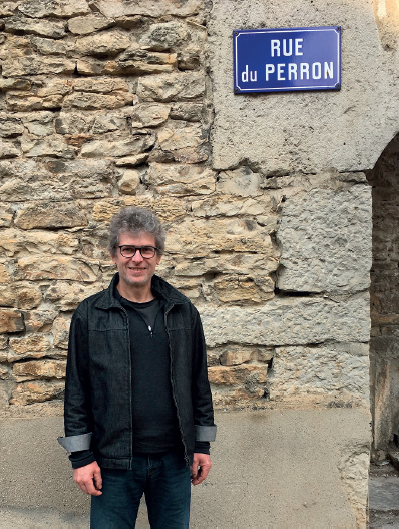
François Grinand’s vineyards in the village of Villebois are in the sector named Perron.
François has my utmost respect for keeping alive the heritage of his village’s vineyard slope. His wines are made resolutely for natural wine aficionados and mainly too funky and volatile for me, but that will not deter everyone, quite the contrary. They are hard to unearth, for they are distributed in so many directions, but rarely within Bugey. It’s a funny old world out there.
La Vigne du Perron
Rue du Village, 01150 Villebois
Tel: 04 74 36 69 37/06 78 53 24 69
Email: fr.grinand@orange.fr
Contact: François Grinand
Map ref: B4
Vineyards: 2.5ha + some purchased grapes
Visits: Preferably by appointment
Thierry Tissot
Tissot is a common name in Switzerland and in eastern France; there’s no family relationship with the famous Tissot vignerons of the Jura, but in Thierry Tissot you can find that same dedication. And it’s shared by his wife, Céline, originally from Lorraine; like Thierry, she has an oenology degree, along with a real love for plants. Their small estate is in conversion to organics after a period of regularly reducing chemical inputs. Among their vineyard parcels is the superb Mataret site, historically valued and once planted with 80ha of vines; now there are just the 3ha Thierry planted with Mondeuse and Altesse from 2001.
Thierry and Céline went far from home for their studies and work experience: Thierry studied in Bordeaux, then Dijon, and worked in St-Emilion, Buxy, Asti in Piemonte, and at Domaine Eugène Carrel of Jongieux in Savoie to learn about Mondeuse and Altesse; Céline did her degree in Montpellier, then worked in Fronton, then in Bergerac as a technical advisor for sustainable vineyard management. Now with children, the couple are firmly rooted in the pretty village of Vaux-en-Bugey, where Thierry can trace his family’s vineyards back to the 19th century. His great-great-grandfather, a mixed farmer, had some vines, a still for making marc and a vine nursery, just after phylloxera. Grandfather Louis and Thierry’s father Jean-Pierre were also mixed farmers and from the 1960s started bottling some wines from their 2ha of vineyards.
In 1998 the family purchased 4ha of land at Mataret, made up of 35 plots owned by 50 different people; it all had to be cleared of brushwood and trees. Thierry began planting vineyards when he joined the estate in 2001. The steep slope goes up to about 360m, basking in the sun all day. The soil is a classic clay-limestone, with well-drained grey/blue marl on top in some areas, ideal for Altesse, and scree in others, better for Mondeuse. To limit yield they use Cordon de Royat training and work very hard on de-budding and canopy management. Some areas are grassed down, but most of the vineyards have been ploughed for over ten years; they now use a small tracked vehicle for weeding. They spray against disease little but often and Céline has been learning more about plant preparations from near-neighbour Jean-Christophe Pellerin. Biodynamics does not interest them yet, although they bottle only during a waning moon. Harvest is manual.
The winemaking is simply done but somewhat technical, using neutral cultured yeasts and shunning oak. CMC bottles their wines and handles the traditional method sparkling wines. The Bugey Brut is delicious, from 40% each of Altesse and Chardonnay and 20% Aligoté/Jacquère, spending three years sur lattes and with just 4g/l dosage; an Extra Dry rosé fizz at 12g/l dosage from Gamay and Mondeuse is sheer fun. A very old family vineyard includes a plot of partly pre-phylloxera Jacquère mixed with some interesting oddities and from this they make an intriguing, intense, dry and light Jacquère IGP Coteaux de l’Ain. Another IGP wine is an off-dry Altesse, from slightly late-harvest grapes. But Thierry Tissot’s pride is the Mataret Altesse, which he says is like a shy person: it takes time to express itself and they release it five years after the vintage. It is stony, rich and elegant, expressing its fabulous vineyard slope; the Mataret Mondeuse combines red fruit and tannin well.

Céline and Thierry Tissot.
Export, especially to the US, now accounts for 20%; for now, 50% is sold in Rhône-Alpes, but demand is increasing elsewhere in France. Céline and Thierry are preserving a piece of Bugey’s heritage with Mataret and by working with local grape varieties. With a little nudging on the winemaking side, their future should be bright.
Thierry Tissot
Quai du Buizin, 01150 Vaux-en-Bugey
Tel: 04 74 35 80 55/06 70 65 96 52/06 81 14 02 17
Email: tissot.bugey@gmail.com
Contact: Céline or Thierry Tissot
Map ref: A5
Vineyards: 5.3ha
Certification: Alpes Contrôles
Visits: Tasting room, preferably by appointment
Domaine Trichon
Stéphane Trichon and his wife Claire run their 13ha-estate organically by absolute conviction. Both lost their grandfathers at a relatively young age and became aware of the risks of chemical pesticides in the vineyards. Claire was born into a wine-growing estate, Domaine La Ligière in Vacqueyras in the Rhône Valley, and Stéphane is the third generation with vineyards here in Lhuis. In the 1950s Stéphane’s grandfather, then a mixed farmer, pulled up his hybrid vines to replant with Vitis vinifera. In 1966 he was joined by son Jean and with 7ha they devoted themselves solely to the vines. Stéphane joined in 2001 and when Claire arrived a few years later they determined to move towards organic farming, starting official conversion from 2008.
The vineyards include one parcel of 4.5ha in Lhuis and the rest scattered through Lhuis and Groslée-St-Benoît. They grow mainly Chardonnay and Gamay, with a little Pinot and Mondeuse, and would like to plant Altesse, but for now are having to regularly replace vines lost to esca. Their oldest vines are a small plot of 40-year-old Molette, which are used with a little Aligoté to spice up the Chardonnay-dominated Bugey Brut.
The vineyards are obviously the couple’s passion. Claire notes that in the old days everyone rotovated the soil and Jean used to plough every other row, swapping every ten years. Now, despite their soil being clay-rich and stony, this is just what they do, adding green fertilizer around harvest time, and by March ploughing it in. Although they do not work with biodynamic preparations, they follow the moon cycles for vineyard work and use various plant concoctions to limit the copper and sulphur sprays. They are close to the Rhône, which brings frequent mists, good for avoiding drought, but not so great for fungal disease. The couple are keen to listen to nature whatever weather it throws at them and are one of the rare estates here to be insured against frost damage. Harvesting is by machine for most of their whites, giving better quality, they believe; reds are picked by hand.
Stéphane took advantage of the low-interest loans offered to young farmers when he arrived to build a modern, gravity-fed stainless steel vinification cellar, inspired by his winemaking stint at Domaine du Vieux Télégraphe in the Rhône Valley. He ferments with indigenous yeasts and still uses the old concrete tanks for malolactic fermentation for reds; the only oak barrel they own was bought in 2016, when they forgot to harvest one vineyard and had to find a small container. The range is straightforward, with a Chardonnay, released after two years, a rosé, and three reds, which I found characterful, especially the soft and fruity Mondeuse. Sparkling is an important part of production: their biggest seller is a Bugey Brut that spends three years sur lattes; there are also two semi-sweet, non-AOC sparklers, ‘made for pleasure’. The Cuisse Rose sparkler from 80% Gamay and 20% Pinot is a big hit and perhaps the only carbonated rosé I might admit to enjoying… two carbonations keep the bubbles fine.
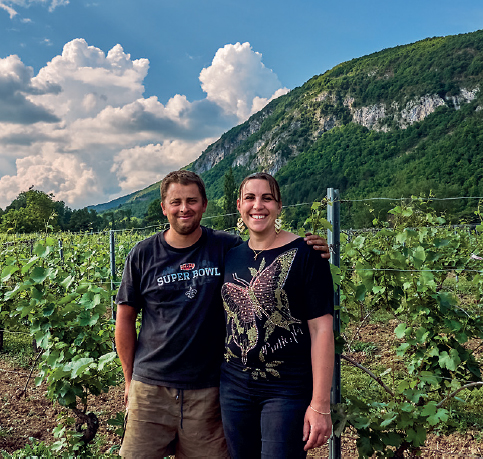
Stéphane and Claire Trichon in their Lhuis vineyard.
The Trichons keep prices low and sell most wines at their tasting room, plus at a few wine shows in Belgium and Luxembourg. They are beginning to export a little to the Netherlands and Russia too. This estate is a real family affair and in the tasting room you can see a joyful mural depicting various family members with their employees and friends. I hope that the current generation, whose attention to detail is admirable, will move the estate forward in quality. They opened a newly renovated self-catering cottage in 2019.
Domaine Trichon
63 Chemin du Lavoir, Le Poulet, 01680 Lhuis
Tel: 04 74 39 83 77
Email: domaine.trichon@gmail.com
Contact: Stéphane or Claire Trichon
Map ref: C2
Vineyards: 13ha (50% Chardonnay)
Certification: Veritas
Visits: Tasting room
Around Belley
There used to be vineyards on the hills all around Belley, but very few remain. In the town, apart from the great Saturday market, there is not much to see in the centre. But nearby is the canalized part of the Rhône river and several attractive lakes, including the Lac du Lit du Roi, good for water sports.
Islands of vineyards are scattered on gentle hillsides from just north of Culoz to just south of Belley. The small town of Culoz was home of the Serpollet brothers, pioneers in making steam-driven cars in the late 19th century. Close to the canalized Rhône, it lies below the imposing Grand Colombier mountain, a southern tail of the Jura range; this has become a regular climb on the Tour de France cycle race, which gives good publicity to Bugey. On Grand Colombier’s south-facing slope a few vineyards remain, whereas once it would have been fully planted.
The densest vineyard areas cluster on the rolling hills around a series of delightful villages including Marignieu, Flaxieu, Vongnes and Ceyzérieu. The latter is the largest; a good small restaurant and wine bar opened here in 2017. In Vongnes, Caveau Bugiste looks after a wine museum. This area is also becoming known for the production of black truffles; prevalent in the 19th century, truffle oaks are once again being planted. A few vineyards lie east of Belley on the gentle hills between the canalized part of the Rhône and the river itself, between Parves and Massignieu-de-Rives, with views across to the Jongieux vineyards of Savoie. Parves are the highest vineyards in the area at 450m. All these vineyards have mixed sedimentary soils, including the ubiquitous limestone, glacial deposits, silt and sandstone.
There are three notable, historically recorded vineyard slopes, all of them farmed principally by Caveau Bugiste: Machuraz, which was once abandoned; Virieu-le-Grand, a Roussette du Bugey cru with just over one hectare; and the cru Manicle with ten hectares in production. Between Cheignieu-la-Balme and Pugieu, Manicle lies below a dramatic cliff, with the vines mainly on limestone scree with some glacial deposits. As required by the cru it must be planted with Chardonnay or Pinot Noir and has four owners: Caveau Bugiste with a 6-ha plot; Domaine Monin with 2ha; about 2ha were planted on barren land in 2017/2018 in association with the owners of the ruined Château des Eclaz; and another 2ha, which were owned until 2018 by a small, historic family estate, André Miraillet. The fourth-generation vigneron farmed ultra-traditionally and his wines sold out immediately on release. Very few restaurants stocked them, but I was able to taste the young 2016 releases at the nearby Auberge de Contrevoz. The white was simple, mineral and delicious; the red was a very pale, ethereal Pinot. André Miraillet had no successors interested in taking over and as we were going to press in 2019 the 2ha planted plus 1ha of barren land within the Manicle cru were sold to a young vigneron from outside the region.
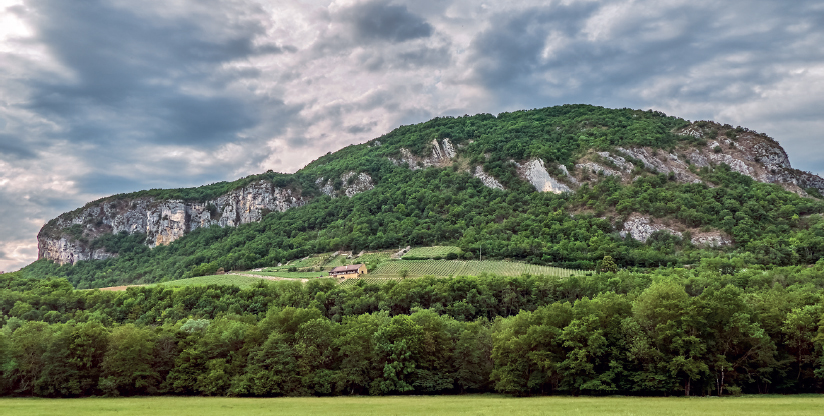
The magnificent Manicle vineyards lie below a dramatic limestone cliff, which provides protection.
Maison Angelot
There’s a kind of symmetry to this family wine estate, which has done much for Bugey. Today it is run by brothers Philippe and Eric Angelot, who took over from their father Maxime and his brother, Gilbert. Maxime was president of the Bugey wine syndicate from 1988 to 1996 as well as mayor of their village, Marignieu. Then from 2008 to 2018 Eric took on the Bugey wine syndicate presidency, at a time when the region finally achieved the much worked-for AOC designation. He has yet to be the village mayor, but he is a proud citizen indeed.
Maxime, who died in 2017 aged 84, started commercializing his wine in bottle from the early 1970s and later in the decade sold his cows to focus on winemaking. He must have been a hard act to follow for Philippe and his younger brother Eric, who joined the family winery in the 1980s. But they seized the challenge to bring their estate into the modern age, shifting the sales little by little towards exports, now at 8%, mainly to the US and Belgium. The welcome at their tasting room means that 50% is sold directly from there, the rest is sold at various wine shows in France and Belgium, and to wholesalers.
This is the largest single family-owned estate in Bugey (nearby Caveau Bugiste and Lingot-Martin in Cerdon are both larger, but owned by several families), producing 180–200,000 bottles per year, about one-quarter being their Bugey Brut, a blend of Jacquère, Aligoté, Molette and Chardonnay with around 9g/l dosage. This, Eric Angelot explained to me, is made to their clients’ taste, but he still manages to sell 15,000 bottles of an Extra Brut Chardonnay with 4g/l dosage, made more to his taste and mine too – this shows how good Chardonnay sparkling wine can be here.
Eric is firm in his opinions on how vineyards must be managed, and the wines made. The vineyards have permanent grass cover and herbicide is applied twice a year under the vines. An intercep is not something Eric is considering as he says what is currently on the market doesn’t suit their training systems and he worries about the environmental impact of the extra fuel use. He blames organic growers for the revival of black rot in the region – he believes using copper and sulphur treatments only is insufficient. Yet it’s obvious that Eric loves his Bugey terroir, wanting his photograph taken by the 500-year-old chestnut tree in one of their older vineyard plots (the light was wrong, so no picture…).
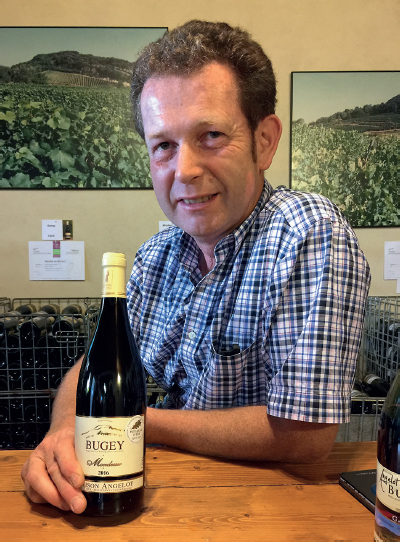
Eric Angelot.
Locally, Maison Angelot’s Cuvée Maxime Chardonnay is listed by all the best restaurants – Maxime Angelot did much to further the cause of growing Chardonnay in these parts. From the estate’s oldest Chardonnay vines, picked late and made only in tank, it can be a little overblown in warmer years. For my taste, the dry, vinous rosé from two-thirds Gamay with Mondeuse, and sometimes Pinot Noir, and the range of reds, are more enjoyable. This is endorsed by Angelot’s US importer, Charles Neal, who ships only the reds. Some thermovinification is used for the two Gamays, an easy-going basic version and the more expensive Reflet du Terroir, which includes a little Mondeuse. I wonder whether the thermovinification flattens them a touch; nevertheless I enjoyed the latter. But Eric describes Mondeuse as his ‘raison d’être’ and it can be very drinkable. Yields are well-controlled; he destems 100% and macerates without pump-over or punch-down at the start in order to protect the fruit character. New for the 2017 vintage was the Mondeuse Cuvée Marignieu, aged in demi-muids, which I have not yet tasted.
Philippe is in charge of sales at the wine fairs, while Eric manages the vineyards and winemaking. Their father was a larger-than-life presence, but Eric’s energy is sure to push the estate and the wines forward. His aim is to increase exports. And waiting in the wings is William, Philippe’s son, currently studying wine at Beaune.
Maison Angelot
121 Rue du Lavoir, 01300 Marignieu
Tel: 04 79 42 18 84
Email: contact@maison-angelot.com
Web: maison-angelot.fr
Contact: Eric Angelot
Map ref: D3
Vineyards: 30ha
Visits: Tasting room open seven days a week
Domaine de Bel Air
It is a reflection of the somewhat perilous commercial state of the Bugey wine region that one of the most spectacularly sited vineyards in this sector has gone through three owners – or strictly speaking tenants – in the past decade. The latest to take over, from January 2017, are two vignerons from Seyssel, Régis Mollex and Pierre Alain Vionnet (see their profiles), who share working the vineyards and making the wines, and have created a joint company to sell wines from their two Seyssel estates along with those from Bel Air. They have ambitions to elevate the status of Bel Air’s wines to equal those from Manicle.
In the 14th century the monks of Arvières cultivated a vineyard on this slope on the foothills of the mighty Grand Colombier. The founders of the estate in its current form – comprising the house, winery and vineyard – were the Férier family, who purchased it in 1920. In the 1970s Madame Michèle Férier formed a liaison with Antoine Riboud, the founder of the Danone food group (owners of Evian mineral water), and the two families developed the wine estate together for some years. Later the wine part of the estate was leased out and at one point the Belmores, an English couple, ran it alongside a Savoie estate in Chautagne. Following a few years of neglect, in 2013 Sacha Mantel, a vigneron from Savoie, took it on, but after a mere four vintages, he moved on too.
Bel Air translates as ‘good air’, describing the regular breeze over the vineyard, which forms a cirque – a steep-sided hollow at the end of the Grand Colombier. This is an extremely stony vineyard on clay-limestone – in fact more stones were added after an impressive landslide in March 2017, when a couple of seriously hefty rocks carved a passage through the vineyard, narrowly missing the house. Well-exposed, facing south-southwest, there is sufficient clay in the subsoil to avoid problems with drought; nevertheless, this site is usually the first to be harvested in southern Bugey.
Bel Air’s vineyards are effectively on one plot, above and below the buildings. Chardonnay accounts for 70%; there is 20% Mondeuse and 10% Pinot Noir, and the plan is to increase the Pinot Noir plantings. Pierre Alain and Régis had to work hard in 2017 and 2018 to tidy up the vineyards and are gradually reducing the amount of chemicals used. They are seeking HVE certification (for sustainability) in 2019 and hope one day to become organic. The cellars are cool, well-equipped and relatively modern and the wines are made here with advice from Oeno Conseil. Unusually for Bugey, oak ageing has been a feature of Bel Air’s wines for some time. Chardonnay and Pinot Noir have always showed the promise of the terroir but in the recent warmer vintages Mondeuse is revealing potential too. A project to watch.
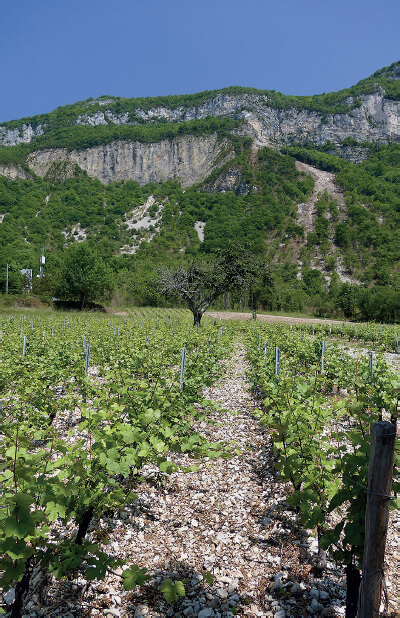
The Bel Air vineyards lie on limestone scree, below the Grand Colombier.
Domaine de Bel Air
Rue Albert Férier, 01350 Culoz
Tel: 06 84 33 14 17 (Pierre Alain Vionnet); 06 81 14 38 71 (Régis Mollex)
Email: sasmollexvionnet@gmail.com
Map ref: E4
Vineyards: 7ha
Visits: Tasting room open on Saturday all day, and Wednesday–Friday afternoons
Sylvain Bois
The French wine guides and competitions love the wines from Sylvain Bois, whose vineyards lie in two neat plots a couple of kilometres apart below Grand Colombier. After a couple of years working in civil engineering, Sylvain decided he preferred to work for himself, outdoors, rather than in a big company office. Supported by his father, after training at Mâcon Davayé, in 2001 he took over a plot of vineyards from his grandfather and bought others, starting his estate with 2ha. He now has 40% red grapes and only 15% of his production is sparkling wine – bucking the local trend – preferring to focus on varietal whites and reds. He built a new cellar in 2011, with a practical set-up of stainless-steel tanks – everything is geared to making it easy to work almost entirely on his own, with help from local wine service CMC for analysis, light filtration and bottling.
Some of Sylvain’s vineyards are very steep and this is one of the reasons he continues to use herbicide below the vine rows, with a strip of grass in between. Although he uses some temporary help, he prefers to do the more intricate work himself. He has calculated that the tractor work to mechanically weed his vineyards would require 175 hours of extra labour between April and July, something he is simply not prepared to pay for. Instead, he has calculated how to use just 10% of the recommended dose of chemical herbicide and uses his systemic fungicides similarly – another reason he shuns organics is that he doesn’t like the use of copper. Two-thirds is machine-harvested and a regular group of pickers harvest the Mondeuse, the steepest vineyard of Altesse and a 60-year-old Chardonnay plot.
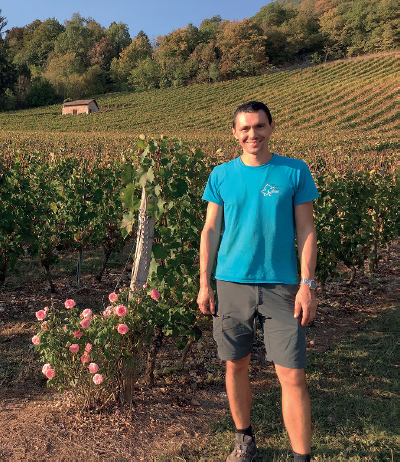
Sylvain Bois below his main vineyard plot.
The wines are made according to the textbook, very clean and balanced, lacking perhaps some character. From 2016, I appreciated Sylvain’s Chardonnay (and it is whites that he generally submits to the competitions); from 2017 it was the Mondeuse that stood out for me as an old-style, structured version of this grape, which is too often unloved in Bugey – Sylvain doesn’t possess a destemmer, but the grapes are crushed in the truck and then the tanks do the rest. For all wines he uses a neutral Champagne yeast to make a pied de cuve, a starter culture to encourage spontaneous fermentation in the tanks. Sylvain aims for maximum permitted yield, which allows him to keep his prices extremely reasonable, but gives him a decent return, as he sells over half his production directly to consumers from his tasting room. Currently he exports about 13% to the Netherlands and Germany.
Sylvain Bois
11 Route de Bourgogne, 01350 Béon
Tel: 04 79 87 23 26/06 88 49 03 95
Email: cavesylvainbois@yahoo.fr
Map ref: D4
Vineyards: 5ha
Visits: Tasting room
Le Caveau Bugiste
In 2017, Caveau Bugiste, whose partners today are Yannick Chaudet and Clément Metge, celebrated its 50th birthday – in many ways, 50 years is a long time in the Bugey wine region. In 1967 Bugey was a vinous backwater with very few wines sold in bottle. Yannick’s father Jean Chaudet (who still works with them) and his grandfather André were among the six founder vignerons who pooled their 4.5ha of vineyards to create Caveau Bugiste, run as a partnership rather than a co-operative. For several years they all continued with dairy and crop farming. Today the vineyards of the partners (and some of the retired partners, including Serge Malik, who retired in 2018 after a quarter century) represent a sizeable amount in this small and fragmented wine area. They produce about 400,000 bottles, or one-quarter of southern Bugey’s wine production, making them by some margin the most important Bugey wine company. Caveau Bugiste offers a fine and diverse range of wines, listed in most of the good restaurants of the area. Effectively, they have led the area from the front for five decades.
The vineyards are generally farmed by the individual associates, while the winemaking equipment, management and sales are shared. Yannick has been the winemaker for 20 years, having studied at Beaune and then done an oenology degree at Montpellier, with several training posts in France and one in the Swan Valley, Australia (surely the most diametrically opposed climate to Bugey).
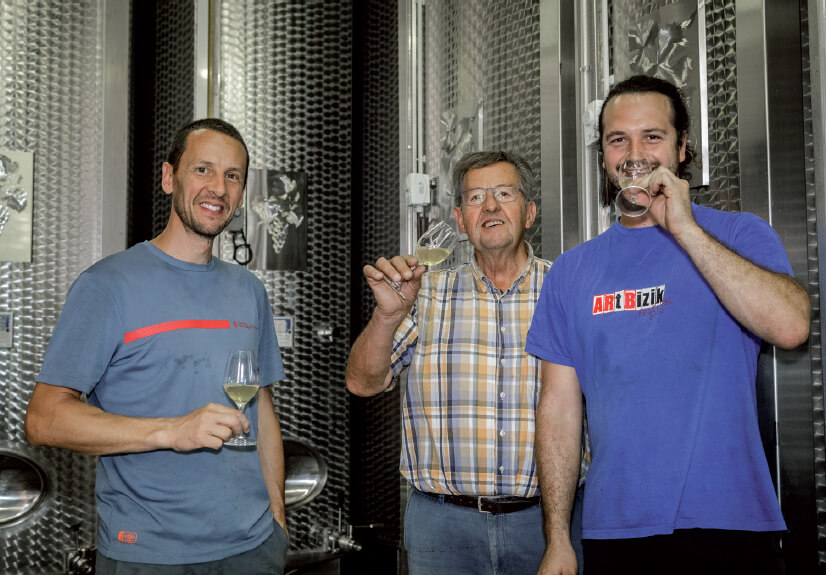
Tasting the new Caveau Bugiste Chardonnay juice are Yannick and his father, Jean Chaudet, with (on right) Clément Metge.
Yannick aims for very ripe grapes and as little cellar intervention as possible. Oak is used for certain of the top vineyard-designate cuvées, buying some new each year and conducting regular tests on different oak origins. For the red wines, part is vinified whole bunch and part destemmed; he favours micro-oxygenation and is dabbling with thermovinification for Gamay; the Manicle Pinot Noir is foot-trodden. Rare for a winery of this size, indigenous yeasts have always been used, with long fermentations and malolactic fermentation the norm. Traditional method sparkling wines represent a quarter of Caveau Bugiste’s production and are aged sur lattes and riddled in their cellars, with CMC handling bottling and disgorgement. Surprisingly, Caveau Bugiste doesn’t have bottling facilities and a Beaujolais-based company brings a mobile line about five times a year.
Caveau Bugiste has holdings on three of the region’s finest vineyard slopes: 6ha on Manicle, purchased in 2000; 1.2ha on Virieu, a monopoly on this Roussette du Bugey cru; and just under 2ha on Machuraz, a wonderful, historic vineyard slope near Artemare, planted about 30 years ago, purchased by Caveau Bugiste in 2012 and farmed organically, without certification. All these are hand-harvested; machine harvesting is used in some of the other sites. Caveau Bugiste was one of the earlier producers in the region to grass down the vineyards and limit weed-killer to below the rows. They are experimenting with an intercep but it will be some years before herbicides are eliminated. Vines in most of the vineyards are at least 30 years old. Most vineyards, including a 10ha plot in Ceyzérieu, are within 3km of the winery. Manicle is 18km away and so equipment and two employees are based in the old winery building on the site.
The quality of the wines is generally good, with an interesting IGP Coteaux de l’Ain range including a Mondeuse Blanche (0.5ha planted in the 1990s), a Molette and an especially delicious Aligoté from 70-year-old vines; some Gamaret is coming on stream soon. There are two very pretty Altesse wines: Roussette du Bugey Tradition and the unique Roussette de Virieu, from the low-yielding, well-exposed and stony site. Yannick believes this needs five years to develop, and the vintage on sale always has two years’ bottle age. An old-vine Bugey Chardonnay is good, but the Machuraz Chardonnay sings. The first vintage was 2012 and Yannick ages it only in tank, with plenty of lees contact. Reds are generally less successful, but from Machuraz comes a classic Mondeuse, with plenty of freshness. The sparkling range is decent and evolving, with a Brut Zero added recently.
I personally loved the Machuraz pair, but the jewel in the crown, where most attention is lavished, is the range from Manicle: Cuvée des Eboulis and Cuvée de l’Amandier Chardonnay, and Cuvée des Rocailles and Cuvée de la Truffière Pinot Noir; in each case the second cuvée is from a selected parcel. Oak maturation is used with all these wines and they reflect this fine vineyard site well. The Eboulis and Rocailles are particularly delicious and good value too, whereas I find the parcel selections a little over-oaky for the nature of the fruit in this region.
In many ways Caveau Bugiste is run like a family business, with several members of the partners’ families working on the sales side, and partners take turns pouring wine at the fairs. Seeing the busy stand at the annual Bugey wine festival, Le Printemps du Bugey, it is obvious that Caveau Bugiste is a highly respected and loved member of the community. Some of this is also due to the way they have valued the heritage of Vongnes, helping it become a local tourist attraction by restoring a grangeon for an excellent winemaking museum and next to it creating a museum of the craft of stonemasonry; old village houses have been converted into cellars and a busy, cute tasting room. Half of the production is sold in the tasting room, and almost all the rest is sold in the wider Rhône-Alpes region. It would be good to see more of the top wines on sale further afield – there is much quality potential here.
Le Caveau Bugiste
326 Rue de la Vigne du Bois, 01350 Vongnes
Tel: 04 79 87 92 32
Email: contact@caveau-bugiste.fr
Web: caveau-bugiste.fr
Map ref: D3
Vineyards: 40ha + about 20ha purchased grapes
Visits: Tasting room
Les Cortis
You are much more likely to know the wines from Les Cortis if you are a fan of authentic wine living in New York, Canada, Scandinavia or Japan than one living in the French Alps. When Jérémy and Isabelle Decoster founded the domaine in 2016 they knew little about Bugey but imagined that their planned production of 25,000 bottles a year would sell locally. But word-of-mouth quickly led importers to snap up their first vintage. Then in 2017, like so many others, they were hit by frost, allowing them to make just 10,000 bottles.
The couple from northern France have quickly settled in the quiet village of Condon, 4km from Belley, close to schools for their children. Although he was brought up in Paris, Jérémy’s family were resolutely beer drinkers from Lille, but, wanting to work outdoors, he found a job in the vineyards in Bordeaux and loved it. A move to Chablis led him to work for the small organic estate, Domaine de Moor, and it was here that he studied wine formally and found inspiration. Some years on, now with Isabelle, they looked for somewhere to call their own, with strict personal criteria. They wanted somewhere sufficiently isolated to convert easily to organics, with widely spaced vine rows to work without cutting the grass, instead using their preferred method of rolling it over. The vineyards from a Bugey grower who wanted to retire fitted the bill – all are close to the village and already grassed down, minimal chemicals had been used simply to keep the cost down. Half the plantings are Chardonnay and there is 1ha Altesse, 1.5ha Gamay, a small plot of Mondeuse and another mixed plot.
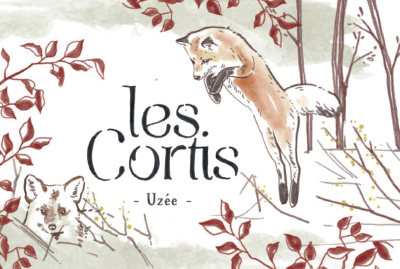
The couple set to work with organic conversion, working the soil mainly manually, limiting vine vigour, adding only manure, and using plant concoctions when needed – up till now only in the dry year of 2018. It is inevitably work in progress, but Jérémy is firm in his convictions of how to work the vineyards best and loves being out there, as does Isabelle, who avoids work in the cellar if she can help it.
Before coming to Bugey, the only local wines Jérémy had experienced were from Adrien Berlioz in Savoie. With no experience of making red wines either, Jérémy knew only that he wanted to use as little intervention as possible, yet he was also determined to avoid the faults of excessive volatility or reduction. Jérémy seems to have the right feel to make wines adapting to the vintage; he questions everything and is adamant that first and foremost he makes wine, rather than natural wine. He has been helped with winemaking by Oeno Conseil and some tips from Savoie’s Jacques Maillet.
Many of the wines are blends, usually sold under a Vin de France label, but the cuvées are likely to change for these first few years. Certainly, Jérémy seems to have a deft touch with whites, with in 2017 a delicious Altesse cuvée called Teraxe, and Xylofaune, a blend of Altesse with Chardonnay and some Aligoté donated by his former employers in Chablis, all aged in oak. A light juicy Gamay with 20% Mondeuse, named Uzée, was spot on too. Les Cortis seems set to become an excellent addition to the line-up of organic Bugey vignerons.
Les Cortis
41 Rue de l’Eglise, Condon, 01300 Andert-et-Condon
Tel: 06 11 73 35 34
Email: decoster.coiffier@gmail.com
Web: lescortis.com
Contact: Jérémy or Isabelle Decoster
Map ref: D3
Vineyards: 6ha
Certification: Alpes Contrôles
Visits: Preferably by appointment
Les Vins de Lavie
Geese for the weeding, crazy labels and a desire to bring back oxen to the vineyards were just some of the ideas Guillaume Lavie brought to Bugey when he arrived in 2015 to join his then-partner Aline, who worked for another vineyard. Guillaume had originally been a landscape gardener, but some contract work with organic winemakers in Burgundy, including Arnaud Ente in Meursault, revealed the magic of wine to him. He went on to study wine in Beaujolais, where he also worked with Domaine Patrice Arnaud.
For three vintages Guillaume and Aline rented 1.3ha of vineyards on the same plot as Caveau Quinard in Parves, one of the highest vineyards in this part of Bugey, which was owned and farmed organically since 2010 by Domaine de Soleyane – an estate that no longer trades. Guillaume started conversion to biodynamic methods and he dislikes tractors or any vineyard machines, which compact the soil, so all was worked either with a horse or manually. Sheep, geese and chickens were used in different years for weeding, and everything possible was done to limit copper and instead use plant concoctions and essential oils to fight disease. Mostly it was planted to Altesse and Mondeuse.
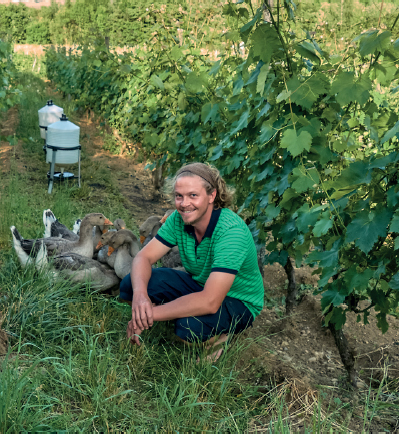
Guillaume Lavie in the Bugey vineyard he farmed biodynamically for three vintages.
Up to the 2017 vintage four wines were made in a rented warehouse in Belley, in which Guillaume installed an old Vaslin press and a few old tanks – he created a barrel room by adding a home humidifier and getting hold of some second-hand barrels. Guillaume likes to handle wine as little as possible and he looked for great finesse in his Altesse and silkiness in the Mondeuse, both AOC Bugey. He certainly achieved that, with each vintage getting better and more capable of ageing. Two Vins de France have been made in a more funky, natural way: a juicy carbonic maceration Pinot named Ro(u)gé, which sold out immediately on release, and a fascinating red blend called Hé Robert from a tiny mixed vineyard parcel which includes Gamay, Mondeuse, Merlot and the hybrid Seibel. This is a man clear in his ideas but who follows life’s callings, so after separating from his partner, his next move makes much sense.
For the 2018 vintage Guillaume decided to move to Savoie and set up as a négociant, named Des Vins d’Envie, with vigneron Maxime Dancoine, who also works for Oeno Conseil. The owners of Domaine de Soleyane took back their vineyards but sold them the grapes, so this means under the Les Vins de Lavie label in 2018 there will only be the Vin de France wines. For the future, Guillaume plans to establish his own small organic estate in Savoie (‘even if it’s conventional, I can make it come alive in three years’), focused on local varieties.
Les Vins de Lavie
1145 Rue des Mettanies, 38530 Pontcharra
Tel: 06 23 12 82 82
Email: lesvinsdelavie@gmail.com
Map ref: B1
Visits: Strictly by appointment
Domaine Monin
By Bugey standards this estate had an illustrious past and was rescued from the brink of extinction by an outsider to the region and to the wine business, Charles Varin-Bernier, who bought it in spring 2015. He has been gradually trying to retrieve the estate’s reputation and move forward.
Founded by Marius Monin, the heyday was under his son Eugène Monin, who in 1965 was one of the first in the region to move from mixed farming into solely winemaking. A year later he became the president of the Bugey growers’ syndicate and remained as president until 1988, at the same time building up his own estate in Vongnes to become one of the most respected in the region. His sons Hubert and Philippe succeeded him and built the estate up to 25ha, including 2ha on Manicle, planted half and half with Chardonnay and Pinot Noir. But things didn’t go so well for them and they began off-loading vineyard parcels, while trying to sell the estate.
Charles, who has worked for 25 years in the international food business, had been looking for a wine estate for some time. He had branched out into being a cheese merchant in Paris and has two shops, one where he ages the cheese. He had often stopped in Bugey while visiting relatives and one day learned about the opportunity to buy Domaine Monin. He bought the 8.5ha of planted vineyard that remained, effectively the best parcels, including Manicle, along with the estate buildings, stock and name.

Charles Varin-Bernier in one of Domaine Monin’s vineyards, above the Lac du Lit du Roi.
Charles divides his time between Paris and Vongnes but has an experienced right-hand man based in Vongnes; he uses the winemaking consultancy services of Oeno Conseil. The Manicle wines and Mondeuse are aged in demi-muids with 20% replaced each year, but in general the cellars lack investment right now. The vineyards needed a lot of work, in particular to make them more environmentally friendly – they were far from it before – and Charles says it will take till 2020 before herbicide use is stopped, but spray treatments are now organic.
Most of the vineyards are grassed down and are split between those near the winery in Vongnes/Ceyzérieu, the prestigious 2ha in Manicle (with some 13th-century dividing walls still in place) and some above the Lac du Lit du Roi with a view across the Rhône to Jongieux. Charles has planted 3ha of virgin land, with a first vintage from part of it in 2018. These new plantings are on fairly rocky steep slopes and alongside Pinot, Gamay and Chardonnay, Charles has planted Roussanne, Mourvèdre and Syrah, which he will make as Vin de France wines and add interest to the range, he believes.
Charles has renovated an old house in Vongnes for a tasting room, although today it accounts for only about 20% of sales. Much is sold to restaurants locally and in Savoie, and Charles is now developing sales in Paris and beyond, hoping to attract export interest.
With reduced yields and improved viticulture the range is slowly improving. Once again, the terroir will out, with both Manicle Blanc and Manicle Rouge showing better than most of the other wines, though still lacking a little soul; whereas the 2017 vintage of Mondeuse Les Perailles showed well, with a juicy, soft structure, reminiscent of Jongieux Mondeuse. I sincerely hope that Charles will succeed in developing the historic Domaine Monin into a fine modern wine estate.
Domaine Monin
255 Chemin des Vignes, 01350 Vongnes
Tel: 04 79 87 92 33
Email: info@domaine-monin.fr
Web: domaine-monin.fr
Contact: Charles Varin-Bernier
Map ref: D3
Vineyards: 11.5ha
Visits: Tasting room
Domaine des Plantaz
Fabrice Gros is one of the few Bugey vignerons with a focus on Altesse, representing more than 20% of his estate. He makes two cuvées, one of them oak-aged and released about five years after harvest. He is also one of the few vignerons to hold back stocks of older wines. I first tasted a mini-vertical of his Altesse in 2011 at a rare tasting of older Bugey wines – the consistency of their expression stood out and those that were 4–6 years old tasted best. Fabrice’s father grew mainly Chardonnay, and with 6.5ha this is the domaine’s most important variety, some vintages partly sold to a négociant. But from early on Fabrice wanted to grow local varieties; he planted the first Altesse vineyards in 1990/91 with his father Bruno, with whom he learned on the job, while doing basic wine studies at Beaune, before becoming a partner in 1995. Bruno was the first in the family to focus solely on winemaking, from 1973, but Albert, Fabrice’s grandfather, already made wine, selling it in barrel to customers in Annecy and to Mollex in Seyssel.
Most of Fabrice’s vineyards are located on a section of the plateau called Sur Plantaz at around 300m above the hamlet of Chavillieu. All the vineyards are close to his cellar, so he is able to work almost on his own, with just two seasonal workers. The vineyards are essentially formed of a glacial till, with a lot of clay, along with some granitic rocks; below is limestone, as everywhere. This soil helps retain acidity in the grapes, even in early harvests. Fabrice notes that until the mid-1990s, his father would always harvest between 1 and 5 October; more recently harvest has usually taken place between 3 and 20 September.
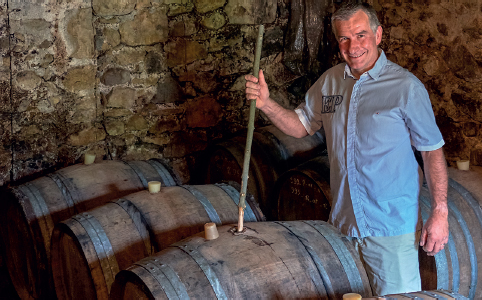
Fabrice Gros uses a wooden pole to stir the lees of his best Altesse wines.
The clay-dominant soil means the grass grows quickly – the vineyards were grassed down from 2011 and in 2012 Fabrice stopped using weed-killer. He uses organic sheep and bird fertilizer, stopped anti-botrytis sprays and insecticides long ago and likes to wait eight years before replanting any plot. From 2018 Fabrice gave up systemic anti-fungal sprays and may seek organic certification. The vineyards are not steep and so white grapes can be machine harvested, another aspect that keeps the prices more than reasonable, which is important to Fabrice.
Climate change has brought drier seasons and in recent years only 2011 gave Fabrice the 55hl/ha he could do with economically, but this genial vigneron laughs this off, saying he usually averages 40hl/ha. The cellar is small but efficiently equipped. Mostly indigenous yeast is used, although he will resort to cultured yeast if necessary. There are temperature-controlled stainless steel tanks along with fibreglass tanks, and Fabrice likes to work with the lees for his whites. Sur Plantaz Altesse is fermented in barrel with malolactic and bâtonnage (lees stirring). Today, Fabrice does almost everything himself with no outside consultant or analyses. He is even equipped for bottling most of the stock, though CMC does a little, as he uses them for bottling and disgorging of his Bugey Brut – a blend of old Jacquère vines planted by his grandfather, with Chardonnay and some Altesse.
Fabrice’s Chardonnay is a delight and his two Altesse wines are serious and distinctly different. The unoaked Altesse can develop Riesling-like petrol notes with a few years of age, and the spicy Sur Plantaz oaked version can marry truffle notes with honey. These are balanced and lovely textured wines. Reds are all destemmed; Fabrice notes that the Mondeuse stems are rarely sufficiently ripe. Some saigné rosé is made to concentrate the Gamay, and both Gamay and Pinot have up to 48 hours of cold maceration. Today he is aiming for softer, fruitier reds than before – the Pinot is from young vines and Fabrice thinks it will gain in expression as the vines age. The first vintage of Mondeuse was 2001 and today he uses some oak ageing – it needs time; 10-year-old Mondeuse from the best vintages can be spot on. Currently Fabrice has just under 2ha of reds (only 0.4ha each of Pinot and Mondeuse), and he would like more, but believes he needs rocky and better drained plots.
Years ago Fabrice exported to the US. Today he works with a distributor in Paris and with wine shops in Lyon, Isère and Ain, plus a few local restaurants. He has lots of plans, but meantime he seems happy and that’s reflected in his wines.
Domaine des Plantaz
46 Chemin de la Source, Chavillieu, 01510 Pugieu
Tel: 04 79 81 47 48
Email: earlgrosfabrice@gmail.com
Contact: Fabrice Gros
Map ref: D3
Vineyards: 11.5ha
Visits: Tasting room
Caveau Quinard
It is fortunate for readers and indeed for this author that before the French Revolution the Quinard family changed their name from Quenard – the name of at least six wine estates in Chignin, Savoie. The family, who had always been farmers, came originally from the Combe de Savoie and migrated over the Montagne du Chat and across the Rhône river to settle in Bugey, by then part of the Kingdom of France. The current generation running Caveau Quinard is Julien Quinard, who has also been the mayor of Massignieu-de-Rives since 2014. The village lies above the Lac du Lit du Roi, just a few kilometres from Jongieux in Savoie.
The family have owned vines for four generations – Julien’s father Maurice, who changed exclusively to viticulture in the mid-1960s, remembers his grandparents’ vines, which were of course, as he remarks, farmed organically. Julien started to work with his father from 2001, after studying viticulture in Belleville, Beaujolais. He took charge of the estate from 2007 – Maurice still lends a hand. The vineyards were converted to organic viticulture, becoming fully certified with the 2012 vintage. Every other row in the vineyards is grassed down and this is swapped every three years, with the soil in the alternate row worked.
Vineyard holdings include a fossil-rich vineyard high up in Parves; and not far from the winery is their most prized vineyard, Coteaux de Son Nant, a very productive slope once part of the Rhône glacier, with a vein of sandstone along with round pebbles of glacial origin. More than half is planted with Chardonnay, some to make a more intense old-vine Coteaux de Son Nant Chardonnay, and some for the estate’s Bugey Brut, which accounts for half its production. The Brut includes some Molette and spends three years sur lattes, giving a delicate, zippy wine, with really good persistence. Altesse is grown in Parves and the 2015 I tried had lovely acidity, balanced by a touch of residual sugar – I can see potential for this wine especially. The wines have been made with indigenous yeast for over a decade, and there is no oak ageing. The few reds made are less successful, and their US importer ships only the whites. Exports are growing and account for 10%, with sales also to Japan and the Netherlands; half is sold at the tasting room and these are among the more visible wines in the local supermarkets.
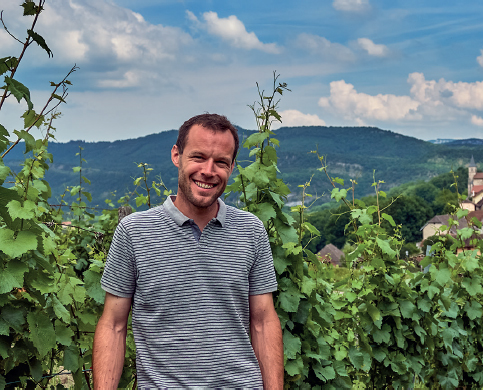
Massignieu-de-Rives vigneron and mayor, Julien Quinard.
After studying wine in Beaune, Sébastien Quinard, Julien’s much younger half-brother, has been working on the estate for a couple of years and officially became a partner in early 2019, helping Julien juggle his administrative commitments outside the winery. Aline Ziemniak, originally a partner in Les Vins de Lavie, also works with them; with a team so dedicated to the local environment, I feel sure that this estate could up their game in the quality of their wines.
Caveau Quinard
201 Route du Lit du Roi, 01300 Massignieu-de-Rives
Tel: 04 79 42 10 18
Email: caveauquinard@orange.fr
Web: caveauquinard.fr
Contact: Julien Quinard
Map ref: D3
Vineyards: 12.5ha
Certification: Veritas
Visits: Tasting room